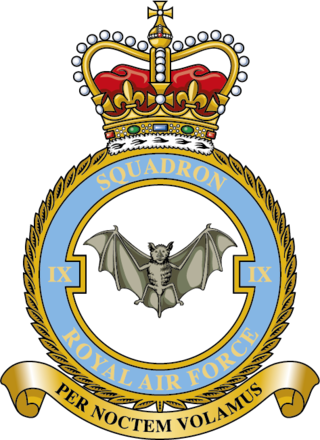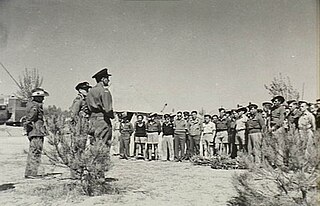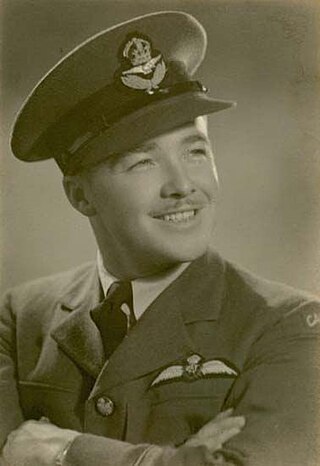
Number 9 Squadron is the oldest dedicated Bomber Squadron of the Royal Air Force. Formed in December 1914, it saw service throughout the First World War, including at the Somme and Passchendaele. During the Second World War, No. IX (B) Squadron was one of two Avro Lancaster units specialising in heavy precision bombing and sank the battleship Tirpitz on 12 November 1944 in Operation Catechism. Between 1962 and April 1982, the squadron flew the Avro Vulcan B.2 as part of the V-Force. In June 1982, it became the first front-line squadron in the world to operate the Panavia Tornado GR.1. In May 1998, No. IX (B) Squadron received the RAF's first Tornado GR.4, which it operated until reequipping with the Eurofighter Typhoon FGR.4 at its present home base of RAF Lossiemouth on 1 April 2019.

No. 41 Squadron Royal Air Force is a flying squadron of the Royal Air Force (RAF), currently operating as the Test and Evaluation Squadron (TES) for the RAF's Typhoon, presently based at RAF Coningsby in the English county of Lincolnshire in the United Kingdom. Its current official abbreviated title is 41 TES. The squadron was originally formed in April 1916, during First World War as part of the Royal Flying Corps (RFC), and served on the Western Front as a ground attack and fighter squadron. Disbanded in 1919 as part of the post-war draw down, No. 41 Squadron was re-formed as an RAF squadron in 1923, and remained on home service until 1935, when it was deployed to Aden during the Abyssinian crisis.

No. 486 (NZ) Squadron was a fighter squadron established for service during the Second World War. It was a New Zealand squadron formed under Article XV of the Empire Air Training Plan. Although many of its flying personnel were largely drawn from the Royal New Zealand Air Force, the squadron served in Europe under the operational and administrative command of the Royal Air Force.

No. 487 (NZ) Squadron was a light bomber squadron established for service during the Second World War. It was a New Zealand squadron formed under Article XV of the Empire Air Training Plan. Although many of its flying personnel were largely drawn from the Royal New Zealand Air Force, the squadron served in Europe under the operational and administrative command of the Royal Air Force as part of Bomber Command. Formed in mid-1942, it operated the Lockheed Ventura and then the de Havilland Mosquito and took part in over 3,000 operational sorties before being disbanded at the end of the war in late 1945.

No. 489 (NZ) Squadron was a torpedo bomber squadron established for service during the Second World War. It was a New Zealand squadron formed under Article XV of the Empire Air Training Plan. Although its flying personnel were largely drawn from the Royal New Zealand Air Force, the squadron served in Europe under the operational and administrative command of the Royal Air Force as part of Coastal Command.

No. 454 Squadron was a unit of the Royal Australian Air Force (RAAF) that served during World War II. The squadron was raised in Australia under the Empire Air Training Scheme in mid-1941, but was disbanded shortly afterwards. It was re-formed later in 1941 from mainly British personnel and subsequently took part in the fighting in the Mediterranean and Middle East theatre before being disbanded in August 1945.

No. 38 Squadron of the Royal Air Force was formed in 1916 as a Home Defence and training squadron, before transferring to France in 1918 as a night bomber squadron. Disbanded in 1919, it was reformed in 1935, and was soon equipped with Vickers Wellington bombers, a type that it operated throughout the Second World War. Having operated across the Mediterranean theatre for much of WWII, at the end of hostilities No. 38 Squadron remained in the area, based at Malta, and undertaking maritime reconnaissance and air-sea rescue duties. After operating the Avro Shackleton in these roles for a number of years, the squadron was disbanded in 1967.

No. 609 Squadron of the Royal Auxiliary Air Force, originally formed as a bomber squadron and in the Second World War active as fighter squadron, nowadays provides personnel to augment and support the operations of the Royal Air Force. The squadron is no longer a flying squadron, but instead has the role of Force Protection. It is currently based at RAF Leeming, North Yorkshire.

No 263 Squadron was a Royal Air Force fighter squadron formed in Italy towards the end of the First World War. After being disbanded in 1919 it was reformed in 1939 flying mainly strike and heavy fighter aircraft until becoming No 1 Squadron in 1958.
No. 189 Squadron was a Royal Air Force squadron.

No. 455 Squadron was a Royal Australian Air Force (RAAF) torpedo bomber squadron during World War II and became famous as part of the "ANZAC Strike Wing" that was formed from Australian and New Zealand squadrons. Raised in early 1941, mainly from Australian personnel, the squadron served over Europe during the war, operating from various bases in the United Kingdom; it also briefly sent a detachment to the Soviet Union in 1942. Operating Handley Page Hampdens and Bristol Beaufighters, the squadron mainly undertook anti-shipping and anti-submarine operations during the war. It was disbanded in May 1945 following the cessation of hostilities against Germany.

No. 466 Squadron RAAF was a Royal Australian Air Force (RAAF) bomber squadron during World War II. Formed in the United Kingdom in late 1942, the squadron undertook combat operations in Europe until the end of the war, flying heavy bomber aircraft. Following the conclusion of hostilities with Germany, the squadron began retraining to undertake operations in the Pacific against the Japanese, but the war came to an end before it left the UK. In late 1945, the squadron was disbanded.

No. 500 Squadron AAF was a Royal Air Force flying squadron. It was initially formed in 1931 as a Special Reserve squadron and in 1936 became part of the Auxiliary Air Force, at this time based at Manston and Detling.

No. 184 Squadron was a Royal Air Force squadron during the second world war.

No. 217 Squadron RAF was a squadron of the RAF. It was formed and disbanded four times between 1 April 1918 and 13 November 1959. In World War I it served in a strike role against enemy bases and airfields in Belgium. In World War II as part of RAF Coastal Command it served first in a maritime patrol role along the Western Approaches and later in an anti-shipping role in the English Channel. Ordered to the Far East in 1942, the squadron was retained for two months in Malta in an anti-shipping role, protecting Allied convoys, before moving to Ceylon to defend the approaches to India, serving in an anti-submarine and anti-shipping role. It was equipped and training for a strike role, when the war ended. In the postwar period, it served for five years in a maritime reconnaissance role, and then briefly in a support role for Operation Grapple, the British hydrogen bomb tests on Christmas Island.
No. 268 Squadron RAF was a Royal Air Force squadron raised during the First World War and in the Second World War operated the North American P-51 Mustang on tactical reconnaissance missions over occupied Europe and in support of the D-Day landings.

No. 219 Squadron of the Royal Air Force was founded in 1918 and disbanded in 1957 after four separate periods of service. During the First World War it served as a coastal defence unit, and through most of the Second World War and the 1950s it operated as a night fighter air defence squadron. Three commanders of the squadron went on to be Chiefs of the Air Staff, two of the RAF and one of the Royal Pakistani Air Force.
Wing Commander John Robert Baldwin, was a Royal Air Force fighter pilot and the top scoring fighter ace flying the Hawker Typhoon exclusively during the Second World War. He went missing during secondment service with the United States Air Force in the Korean War and was presumed killed.

Jack Rife Beirnes was a Royal Canadian Air Force squadron leader who flew Kittyhawk fighters on home defense in Canada and then commanded a squadron of Hawker Typhoons over Europe during the Second World War. He was awarded the Distinguished Flying Cross and Bar for his successes while serving with No. 438 Squadron RCAF. He lost his life in a flying accident at the end of his third combat tour.

Squadron Leader Ian Dousland Waddy, was a fighter pilot of the Royal New Zealand Air Force during the Second World War. He was an original member of No. 486 Squadron RNZAF, rising to become its commanding officer. He was shot down on 25 August 1944 while commanding No. 164 Squadron RAF, becoming a prisoner of war.

















